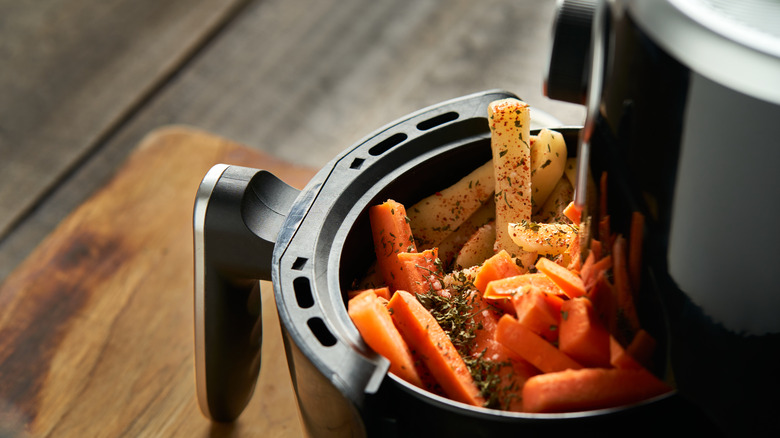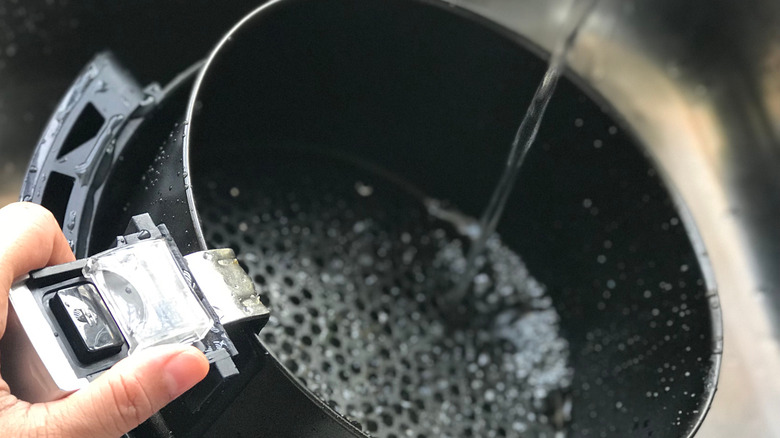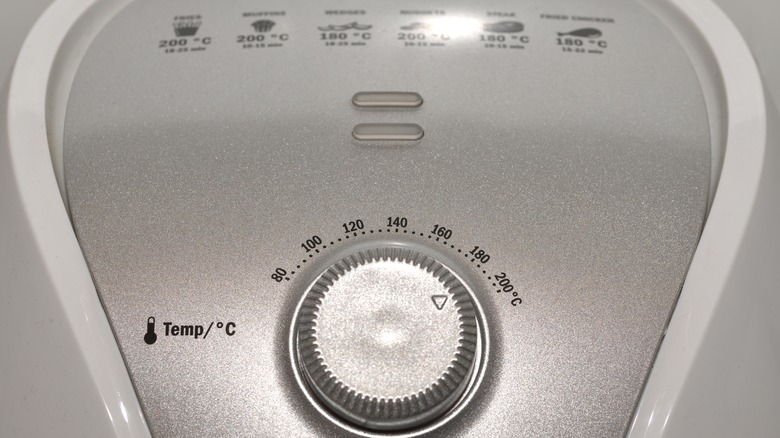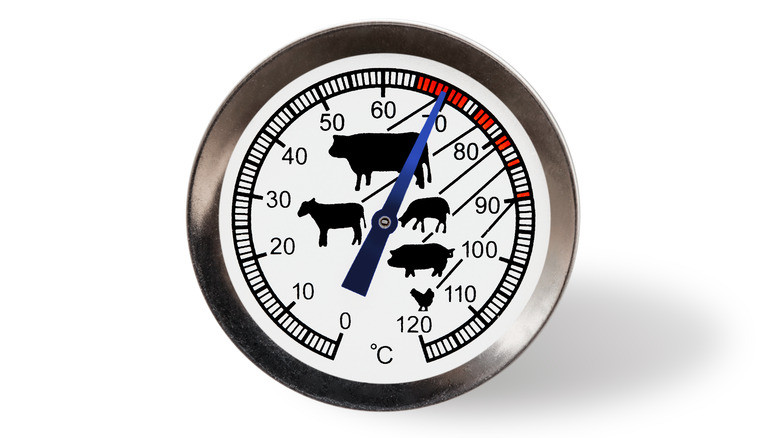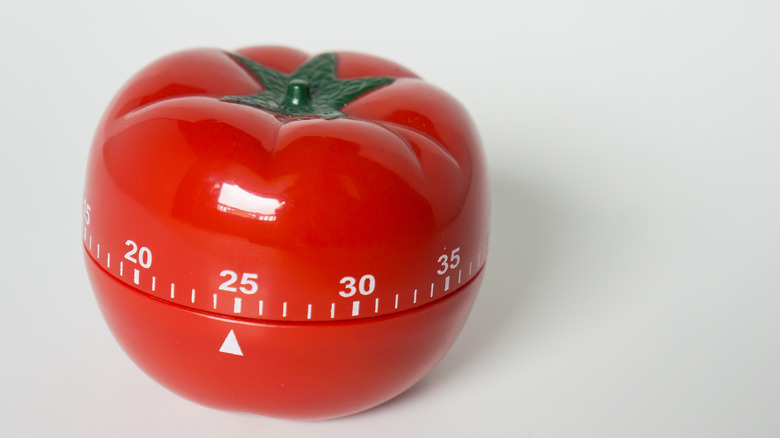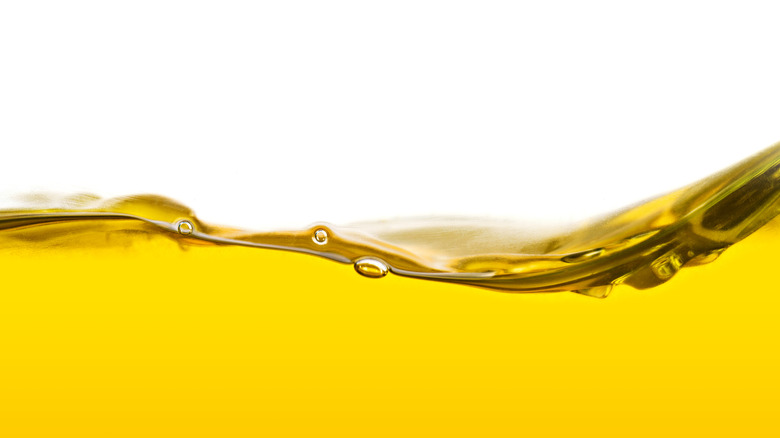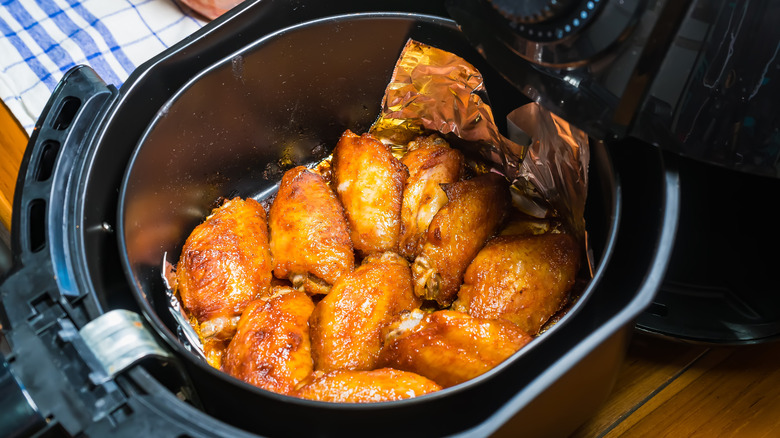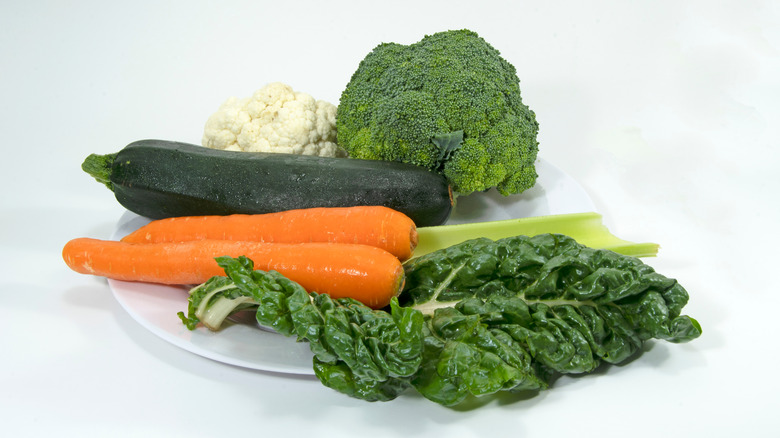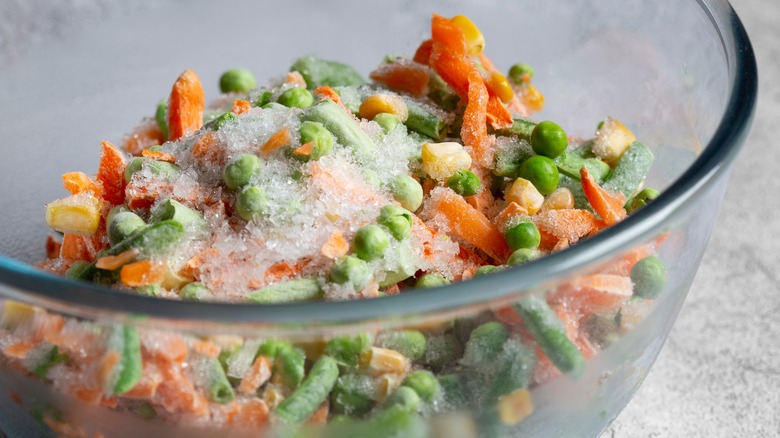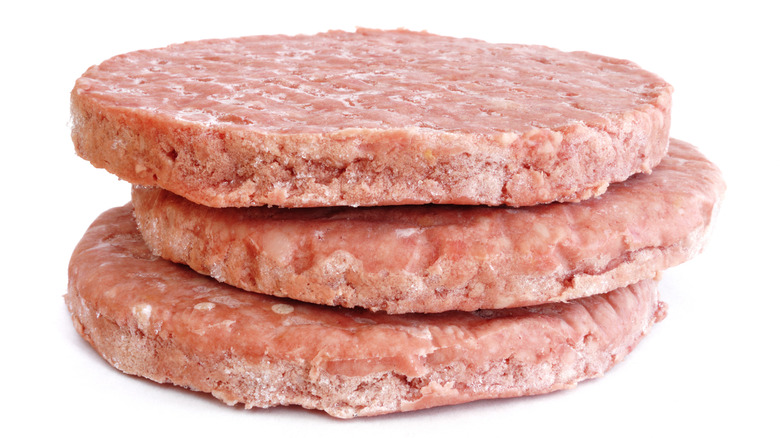Mistakes Everyone Makes Cooking Frozen Food In The Air Fryer
Frozen foods and air fryers; the duo seems simple enough. You just pop whatever frigid delectable you're craving into that quick cooker and the result is perfectly crispy, crunchy, and cooked through, right? If only it was that straightforward. Unfortunately, when it comes to the magical, mystical air fryer, it's not all rainbow sprinkles. And when you add in the element of frozen food, it can make using the appliance a bit more of a daunting experience.
Amidst technical errors and foodie faux pas, these miniature countertop ovens have seen a surging tidal wave in popularity. In fact, PR Newswire estimates that the air fryer market can expect to increase by a staggering $350.89 million by the end of 2026. Nonetheless, there are still more than a few issues to contend with when cooking with the device. Not only is there an air fryer for pretty much every occasion, but food (especially if frozen) can have its own quirks as well.
There's no reason to give up hope, though. You can conquer your uncertainties head-on because we've collected some solid solutions for common mistakes everyone makes when cooking frozen food with an air fryer. And you'll be glad to know that they're all pretty simple fixes.
Your air fryer is dirty
How often do you think you should be cleaning your air fryer? Daily? Weekly? Monthly? Whenever you get around to it? A quick search on the internet produces incredibly mixed results. (Bummer.) Reputable sources like Food Network state that it's not entirely necessary to deep clean your cooker after every fry session, and that it really depends on how much buildup or food debris is hanging out inside. On the other hand, Consumer Reports claims it's an absolute no-no to put off cleaning the entire air fryer after each use, or else it will be a complete nightmare to clean the next time.
All in all, the consensus is that cleaning your air fryer more often than not is a good practice to keep. Yes, it'll take some extra time in the kitchen, but the benefits are well worth it. Frequently cleaning your air fryer not only helps to extend its life but also keeps it from developing questionable smells (via Insider). It also eliminates any chance that those remaining crumbs will catch on fire the next time you're using your air fryer. Just like any appliance — and machinery in general — maintenance and cleaning are key. You wouldn't run your car without oil, right?
You're not preheating your fryer
It may seem like a no-brainer, but it's pretty important to spend a few extra minutes preheating your air fryer. Would you toss a frozen pizza into a cold oven? Of course not, and any pizza box will explicitly indicate that you must preheat the oven. The same goes for any food, frozen or fresh, that you're tossing into your air fryer.
According to Insider, among the multitude of reasons why preheating the appliance is necessary, first and foremost it ensures that your food will begin to cook immediately. It also guarantees that your meal will be crispy and delicious on the outside and cooked evenly and all the way through on the inside.
Keep in mind that using the preheating feature on your air fryer also means that your food will also cook faster. So if you seriously need to get your frozen veggie tempura fix, it's worth waiting a few extra minutes in the beginning to have a pleasant and satisfying meal. It's also important to note that some air fryers automatically preheat, while others need to be manually set. So be sure to know how your device functions to avoid assuming it's preheating when it's just been blankly staring at you wondering when you're going to turn it on.
You're cooking at the wrong temperature
While most frozen foods come with cooking instructions, they're normally not geared toward the newfangled air frying method. You'll typically read about frying, sauteeing, baking, or a good old-fashioned arterial clogging deep-fry. The norm will probably soon change though, because air fryer sales have increased by 76% since January 2020, according to the market research group, NPD.
With limited heating instructions, the fact that no two air fryers are the same makes it even trickier to determine exactly how to prepare your favorite frozen foods. Temperature settings and capacity are two major variables that will greatly affect your success rate. Air fryers come with user manuals and sometimes include handy little recipe books, too. Consequently, it's best to follow the basic guidelines that are provided with your particular air fryer.
If you've somehow misplaced your manual, search the wonderful World Wide Web for the manual that goes with your particular air fryer instead of playing a guessing game. If that sounds like too much work, the general rule of thumb is to start cooking at 350 F. When in doubt, you can also look at online oven-to-air fryer conversion calculators.
You're cooking for the wrong duration
The whole set it and forget it style of cooking has made socializing during dinnertime or parties a far safer prospect. Nothing's worse than turning your back on your oven for just one minute too long and coming back to a blackened dish. That being said, no one likes to take a bite out of a formerly frozen finger food only to discover that it's still cold in the middle. And the last thing you want to do is give your friends or family a serious case of salmonella (via Family Guide Central).
Timing and temperature go hand in hand and they vary dramatically from food to food. You want to avoid cooking your frozen items for so long that they dry out past the point of saving. But you also don't want to risk consuming undercooked food. If you stick with the handy-dandy guide that comes with your fryer or simply use a conversion calculator, you'll be geared for success.
To help guide you, AirFrying.net has a chart that provides a general time frame for cooking your frozen nom noms. Above all, investing in a food thermometer is the easiest way to eliminate any uncertainty and prevent a bad case of tummy troubles. (Unfortunately, it won't help you if overcooking food is your unintentional favorite pastime.)
You're using the wrong oil
If the recipe calls for it or you just need some extra crisp in your frozen food fry fest, there are a few factors to keep in mind when it comes to the addition of oil. First, you're going to want to use an oil that has a neutral flavor, but you're also going to want to make sure that it has a high smoke point, also known as the burning point (via MasterClass). These types of oils hold up well for high-heat cooking and won't easily burn. Refined avocado oil, safflower oil, light or refined olive oil, or soybean oil are all good options to use in air fryers and for cooking frozen goodies (via Air Frying Foodie).
In addition to sticking with neutral-tasting, high smoke point oils, you're also going to want to steer clear of cooking sprays, like PAM. Non-stick sprays usually contain added lecithin, which is a naturally occurring fat found in foods like egg yolks and soybeans, known for its amazing emulsifying capabilities (via Everyday Health). The problem with using it on non-stick or Teflon surfaces is that this innocuous (yet controversial) additive will build up a layer. This makes non-stick surfaces sticky and can also begin to deteriorate the coating on the inner basket.
Or you're using too much oil
When it comes to measuring ingredients, the general rule of thumb to follow is that you can always add more but you can't subtract. That goes for most, if not all, flavor enhancers. For example, too much salt or pepper can pretty much turn a dish from delightful to disastrous. The same holds true for oil — a little goes a long way.
That being said, one of the reasons air fryers are so darn amazing is that they're great at cutting back on excess fat and grease. When compared to deep-frying or similar hot oil cooking, using an air fryer can cut fat by up to 75%, as reported by Healthline. Interestingly enough, the appliance wasn't originally intended to be crowned the countertop kitchen cook-all king. The New York Times reports that air fryers were merely created to make crispy fries at home.
Even though their name implies it, air fryers don't actually fry foods (via Cleveland Clinic). When it comes to producing a crispy texture, some frozen foods don't even need added oil because they already contain some. Keep in mind that you're also using an air fryer to eliminate any unnecessary fats and oils, right? But if the recipe calls for it, a few tablespoons used sparingly should suffice.
You're overcrowding your fryer
Nothing good comes from overcrowding. (Just ask anyone who's ever been stuck in an inner tube at a wave pool in the middle of summer.) Overcrowding, aka overfilling, an air fryer is common when individuals are trying to cook more food in a short amount of time. Unfortunately, adding too much to your air fryer at once causes your food to cook inconsistently (via America's Test Kitchen). So unless you're cooking for a bunch of people who like half crispy, half soggy, and possibly undercooked food, use your better judgment. Overcrowding means that you're also probably going to end up tossing what you made, ultimately resulting in waste.
Air fryers use a method of cooking known as convection, which means that food is cooked via free flowing hot air (via Insider). So in order to properly work its fry-tastic magic, your kitchen countertop gizmo needs to be able to freely circulate hot air around the pieces of food. If air can't move around, then your snackaroos will suffer. For best results, fry your food in batches, not in bulk.
You're treating all your veggies equally
Some veggies — like the odoriferous Brussel sprout — fry up quite nicely in an air fryer. So does zucchini, even though it's over 90% water. That being said, other vegetables don't fare so well. Since these countertop ovens circulate hot air to crisp and cook ingredients, leafy greens like spinach, kale, and Swiss chard refuse to stay put in the fryer basket once the hot air begins to circulate and basically go flying.
Other cruciferous vegetables, like broccoli, for example, become parched and brittle when cooked in an air fryer. This also makes them more prone to burning. Essentially, the appliance turns these types of produce into dust. If you're set on trying to air fry that gorgeous purple broccoli you recently purchased at a farmers market, then remember to use larger pieces, coat them with a neutral high smoke point oil, and avoid overcrowding your fryer basket.
You're defrosting your frozen food
One of the best features of air fryers is that they're basically just miniature versions of a normal convection oven. Would you defrost frozen food when you cook it in a standard range or toaster oven? Probably not. The same rule applies when you're using an air fryer — there's no defrosting required.
According to the Academy of Nutrition and Dietetics, the cooking time for frozen proteins will need to be increased by up to 50%, but pretty much any frozen vegetable can be cooked from its frosty form. Keep in mind that in order for your protein to be considered safe to eat, it needs to reach a certain inner temperature. The U.S. Department of Agriculture (USDA) notes that chicken should have an internal temperature of at least 165 F and seafood, shellfish, and meaty roasts (including pork and lamb), should reach 145 F. Don't forget to let the meat rest for at least three minutes to allow the juices to reabsorb into the meat.
If your frozen veggies always seem to end up soggy after a run-in with the air fryer, the secret is to keep them in the freezer until your appliance has finished preheating. Once you're ready to cook, pull your vegetables out of the freezer, toss them into the fryer basket, and get ready for crispy-fried produce (via Build Your Bite).
You're attempting to cook frozen hamburgers
There are some frozen foods you should simply not cook in an air fryer. Frozen steak, unbattered frozen seafood, and unfortunately, even frozen hamburgers are all just a bad idea. The latter poses a few issues, the first being with the air fryer itself. As we've already established, no two air fryers are exactly alike, especially when it comes to cooking temperature. While one model could cook your frozen meat patty to perfection, another may turn it into a dried-out meaty hockey puck. Or worse — you could end up with the complete opposite and chomp down on an undercooked burger.
The Healthy reports that undercooked meat can contain salmonella and E. coli (among other bacterial party crashers), making it the winner when it comes to ways to contract food poisoning. Ground meat is particularly prone to spreading these pathogens because there's more surface area to expose the potentially contaminated meat (via USDA).
Keep it simple and just don't attempt to cook a frozen hamburger in your fryer. If you're craving a juicy burger, take the time to do it right and stick to grilling, pan-frying, or broiling it. Treat yourself — just not to a case of food poisoning.
